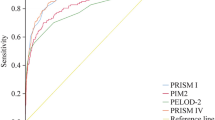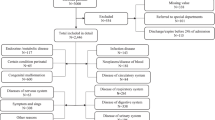Abstract
Objective
To validate Pediatric Risk of Mortality (PRISM) and Pediatric Index of Mortality (PIM) score.
Methods
All consecutive patients over a six month period were included in the study except patients with a PICU stay of less than 2 hours, those transferred to other PICUs, pediatric surgical cases, trauma patients and those dying within 24 hours of admission. The PRISM and PIM scores of all patients included in the study were computed and the outcome was noted in terms of survival or non-survival. Mortality discrimination was quantified by calculating the area under the receiver operating characteristic (ROC) curve. Hosmer and Lemeshow goodness-of-fit test was used to calibrate the scores.
Results
Two hundred and thirty patients were enrolled with mean age of 40.6 months and male to female ratio of 1.2:1. There were 56 deaths (mortality rate 24.3%). The mortality in infants was higher (37.8 %) as compared to non-infants (16.2 %) (p = 0.011). The predicted deaths with PRISM score was 24.3%. The area under the ROC curve was 0.851 (95% CI 0.790–0.912). The Hosmer and Lemeshow goodness-of-fit test showed good calibration (p=0.627, chi square =1.75, degree of freedom = 3). The predicted deaths with the PIM score was 7.38%. The area under the ROC curve for PIM score was 0.838 (95 % CI 0.776–0.899). The Hosmer and Lemeshow goodness-of-fit showed a poor calibration for PIM score (p = 0.0281, chisquare = 10.866, degree of freedom = 4).
Conclusion
Both PRISM and PIM scores have a good discriminatory performance. The calibration with PRISM score is good but the PIM score displays poor calibration.
Similar content being viewed by others
References
Teres D, Lemeshow S. Using severity measures to describe high performance intensive care units. Crit Care Clin 1993; 9: 543–554.
Pollack MM, Ruttimann UE, Getson PR. Pediatric risk of mortality (PRISM) score. Crit Care Med 1988; 16: 1110–1116.
Shann F, Pearson G, Slater A, Wilkinson K. Paediatric index of mortality (PIM): a mortality prediction model for children in intensive care. Intensive Care Med 1997; 23: 201–207.
Seneff M, Knaus WA. Predicting patient outcome from intensive care: a guide to APACHE, MPM, SAPS, PRISM, and other prognostic scoring systems. J Intensive Care Med 1990; 5: 33–52.
Thukral A, Lodha R, Irshad M, Arora NK. Performance of Pediatric Risk of Mortality (PRISM), Pediatric Index of Mortality (PIM) and PIM2 in a pediatric intensive care unit in a developing country. Pediatr Crit Care Med 2006; 7: 356–361.
Singhal D, Kumar N, Puliyel JM, Singh SK, Srinivas V. Prediction of mortality by application of PRISM score in intensive care unit. Indian Pediatr 2001; 38: 714–719.
Lacroix J, Cotting J. Severity of illness and organ dysfunction scoring in children. Pediatr Crit Care Med 2005; 6[Suppl.]: S126–S134.
Marcin JP, Pollack MM. Review of the methodologies and applications of scoring systems in neonatal and pediatric intensive care. Pediatr Crit Care Med 2000; 1: 20–27.
Lemeshow S, Hosmer DW. A review of goodness-of-fit statistics for use in the development of logistic regression models. Am J Epidemiol 1982; 115: 92–106.
Te CT. Introductory Biostatistics, New Jersey: Wiley-Interscience; 2003.
Kapil D, Bagga A. The profile and outcome of patients admitted to a pediatric intensive care unit. Indian J Pediatr 1993; 60: 5–10.
Khilnani P, Sarma D, Zimmerman J. Epidemiology and Peculiarities of Pediatric Multiple Organ Dysfunction Syndrome in New Delhi, India. Intensive Care Med 2006; 32: 1856–1862.
Bhal S, Tygai V, Kumar N, Sreenivas V, Puliyel JM. Signs of inflammation in children that can kill (SICK score): Preliminary prospective validation of a new non-invasive measure of severity-of-illness. J Postgrad Med 2006; 52: 102–105.
Kramer AA, Zimmerman JE. Assessing the calibration of mortality benchmarks in critical care: The Hosmer-Lemeshow test revisited. Crit Care Med 2007; 35: 2212–2213.
Martha VF, Garcia PC, Piva JP, Einloft PR, Bruno F, Rampon V. Comparison of two prognostic scores (PRISM and PIM) at a pediatric intensive care unit. J Pediatr Rio J 2005; 81: 259–264.
Bertolini G, Ripamonti D, Cattaneo A, Apolone G. Pediatric Risk of Mortality: An assessment of its performance in a sample of 26 Italian intensive care units. Crit Care Med 1998; 26: 1427–1432.
Gemke RJ, Bonsel GJ, van Vught AJ. Effectiveness and efficiency of a Dutch pediatric intensive care unit: Validity and application of the Pediatric Risk of Mortality score. Crit Care Med 1994; 22: 1477–1484.
Balakrishnan G, Aitchison T, Hallwoth D, Morton NS. Prospective evaluation of the Pediatric Risk of Mortality (PRISM) score. Arch Dis Child 1992; 67: 196–200.
Marcin JP, Pollack MM, Patel KM, Ruttimann UE. Decision support issues using a physiology based score. Intensive Care Med 1998; 24: 1299–1304.
Pollack MM, Patel KM, Ruttimann UE. PRISM III- an updated pediatric risk of mortality score. Crit Care Med 1996; 24: 743–752.
Slater A, Shann F, Pearson G. PIM 2: a revised version of the Paediatric Index of Mortality. Intensive Care Med 2003; 29: 278–285.
Author information
Authors and Affiliations
Corresponding author
Rights and permissions
About this article
Cite this article
Taori, R.N., Lahiri, K.R. & Tullu, M.S. Performance of PRISM (Pediatric Risk of Mortality) score and PIM (Pediatric Index of Mortality) score in a tertiary care pediatric ICU. Indian J Pediatr 77, 267–271 (2010). https://doi.org/10.1007/s12098-010-0031-3
Received:
Accepted:
Published:
Issue Date:
DOI: https://doi.org/10.1007/s12098-010-0031-3




